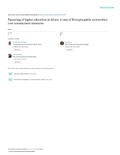| dc.contributor.author | WAWERU, KN | |
| dc.contributor.author | Abate, Sewale | |
| dc.contributor.author | HUKA, GH | |
| dc.contributor.author | Dawe, Shano M | |
| dc.date.accessioned | 2018-11-01T09:41:42Z | |
| dc.date.accessioned | 2020-02-07T08:38:39Z | |
| dc.date.available | 2018-11-01T09:41:42Z | |
| dc.date.available | 2020-02-07T08:38:39Z | |
| dc.date.issued | 2011 | |
| dc.identifier.uri | http://repository.must.ac.ke/handle/123456789/1291 | |
| dc.description.abstract | With the tremendous increase in university students enrolments experienced in Ethiopian public universities since years 2005, financing of university education has become topical issue among education stakeholders. This paper explores extent to which Ethiopian public universities have instituted cost containment measures to bridge the financing gap occasioned by the limited public funding. The study which is exploratory in nature, sampled eight public universities that have been
in existence for more than two years. Findings indicated that the academic staff ratios and non academic staff ratios were sub optimal and below those of selected African universities. Physical facilities utilization was also found to be sub optimal. Most of the universities managed all noncore services rather than outsource as is the common practice and most universities did not have an inventory of facilities. The study’s findings indicate that more students and programmes could be
implemented within the existing infrastructure in Ethiopian public universities, if the resources available were used efficiently. | en_US |
| dc.language.iso | en | en_US |
| dc.publisher | Educational Research | en_US |
| dc.subject | Cost Containment, Academic Staff Ratio, Non-academic Staff Ratio, Outsourcing. | en_US |
| dc.title | Financing higher education in Africa: A case of Ethiopia public universities cost containment measures | en_US |
| dc.type | Article | en_US |

